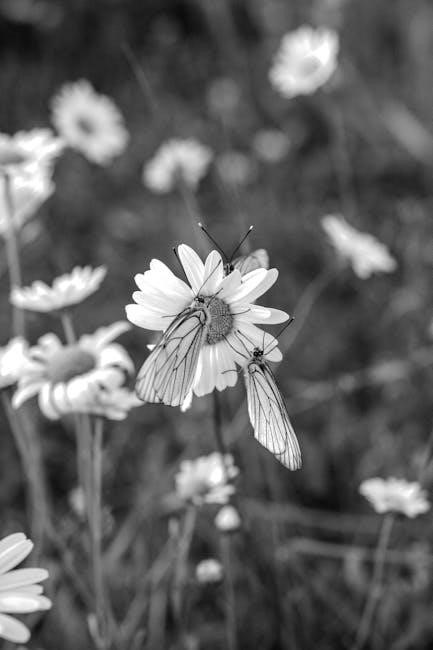1․1 Overview of “In the Time of the Butterflies” by Julia Alvarez
In the Time of the Butterflies‚ written by Julia Alvarez‚ is a powerful blend of historical facts and fiction‚ recounting the tragic story of the Mirabal sisters‚ who courageously resisted the oppressive Trujillo regime in the Dominican Republic․ The novel explores themes of freedom‚ sacrifice‚ and family‚ with the butterfly symbolizing transformation and hope․ Alvarez’s vivid storytelling brings to life the sisters’ struggle‚ creating a timeless tale of resilience and inspiration․

In the Time of the Butterflies by Julia Alvarez is a captivating historical fiction novel that honors the lives of the Mirabal sisters‚ who defied the oppressive Trujillo regime in the Dominican Republic․ The book weaves their true story with fictional elements‚ creating a poignant narrative of courage‚ love‚ and sacrifice․ Alvarez’s vivid storytelling brings to life the sisters’ struggles‚ their unwavering commitment to freedom‚ and their ultimate sacrifice․ The novel‚ which has reached its 25th anniversary‚ continues to resonate globally‚ inspiring readers with its themes of resilience and hope․ Alvarez’s work remains a powerful tribute to the Mirabal sisters’ enduring legacy․

1․2 Historical Context of the Dominican Republic Under Trujillo
The Dominican Republic under Rafael Trujillo’s dictatorship was marked by repression and fear․ Trujillo ruled with an iron fist from 1930 to 1961‚ suppressing dissent and opposition through violence and surveillance․ His regime was characterized by human rights abuses‚ political executions‚ and a cult of personality․ The economy was controlled by Trujillo and his allies‚ leaving many Dominicans in poverty․ The Mirabal sisters’ resistance was part of a broader movement against Trujillo’s tyranny‚ which ultimately led to his downfall․ This oppressive era serves as the backdrop for Julia Alvarez’s novel‚ highlighting the courage of those who dared to challenge Trujillo’s regime and fight for freedom․

The Mirabal Sisters: Real-Life Heroes
The Mirabal sisters were real-life heroines whose courage and activism inspired Julia Alvarez’s novel․ Their story symbolizes resistance against oppression and the fight for freedom and justice․
2․1 Biographies of the Mirabal Sisters
The Mirabal sisters—Patria‚ Minerva‚ María Teresa‚ and Dedé—were born in the Dominican Republic during the early 20th century․ Patria‚ the eldest‚ was deeply religious and nurturing‚ while Minerva‚ the most rebellious‚ became the driving force behind their political activism․ María Teresa‚ the youngest‚ was romantic and idealistic‚ often expressing her feelings through writing․ Dedé‚ the only sister to survive‚ became the keeper of their legacy․ Their distinct personalities and shared commitment to justice made them symbols of courage․ Their lives under Trujillo’s dictatorship shaped their destinies‚ leading to their tragic fate in 1960․ Their story‚ immortalized in Alvarez’s novel‚ continues to inspire global audiences․
2․2 Their Role in the Resistance Against the Trujillo Regime
The Mirabal sisters played a pivotal role in the resistance against Rafael Trujillo’s regime‚ known for its brutality and repression․ Minerva‚ the most politically active‚ cofounded the Movement of the Fourteenth of June‚ seeking to overthrow Trujillo․ Her sisters‚ Patria and María Teresa‚ joined her‚ distributing anti-Trujillo pamphlets and supporting underground activities․ Their efforts defied the regime’s oppressive tactics‚ inspiring others to seek freedom․ Despite the risks‚ they remained committed to justice‚ even as their actions led to imprisonment and‚ ultimately‚ their tragic deaths in 1960․ Their bravery became a symbol of resilience and defiance against dictatorship‚ immortalized in Alvarez’s novel․

Themes and Symbolism in the Novel
The novel explores themes of resistance against oppression‚ the pursuit of democracy‚ and personal sacrifices‚ while the butterfly symbolizes hope and transformation under Trujillo’s regime․
3․1 The Significance of Butterflies as a Symbol
The butterfly emerges as a poignant symbol in In the Time of the Butterflies‚ representing transformation‚ resilience‚ and hope․ The Mirabal sisters‚ known as “Las Mariposas‚” embody this symbolism‚ their delicate yet unyielding resistance mirroring the butterfly’s fragile beauty and strength․ Alvarez uses the butterfly to signify the sisters’ metamorphosis from ordinary women to revolutionary figures‚ their fight for freedom and justice transcending death․ The butterfly also symbolizes the fleeting nature of life under Trujillo’s regime and the enduring legacy of their struggle․ It becomes a powerful metaphor for the human spirit’s capacity to inspire change and seek a better future․
3․2 Themes of Freedom‚ Sacrifice‚ and Family
In the Time of the Butterflies explores profound themes of freedom‚ sacrifice‚ and family‚ set against the backdrop of the Trujillo dictatorship․ The Mirabal sisters’ fight for freedom highlights their willingness to sacrifice everything for justice and democracy․ Family bonds are central‚ as their relationships provide strength and motivation․ The novel portrays how personal and political struggles intertwine‚ with the sisters’ love for their family fueling their resistance․ Alvarez vividly depicts the emotional toll of their sacrifices‚ emphasizing the resilience of the human spirit․ These themes resonate universally‚ making the novel a powerful exploration of courage‚ loyalty‚ and the enduring impact of familial ties in the face of oppression․

The Author: Julia Alvarez
Julia Alvarez‚ born in New York City‚ draws from her Dominican heritage to craft powerful narratives․ Her In the Time of the Butterflies reflects her connection to the Mirabal sisters‚ creating a poignant tribute to their sacrifice and resilience․
4․1 Background and Inspiration for Writing the Novel
Julia Alvarez’s inspiration for In the Time of the Butterflies stemmed from her personal connection to the Dominican Republic and the Mirabal sisters’ story․ Her family fled the Trujillo regime in 1960‚ giving her a unique perspective on the era․ Alvarez felt a deep responsibility to honor the sisters’ memory‚ blending historical facts with fictionalized narratives․ Drawing from interviews‚ historical records‚ and her own experiences‚ she crafted a compelling tale of resistance and sacrifice․ The novel became a tribute to the sisters’ bravery and a reflection of Alvarez’s dual identity as a Dominican-American writer․
4․2 Alvarez’s Personal Connection to the Dominican Republic
Julia Alvarez’s personal connection to the Dominican Republic is deeply rooted in her family’s history․ Born in New York but raised in a Dominican household‚ her parents fled the Trujillo regime in 1960․ Alvarez’s experiences as a Latina in the U․S․ and her visits to the Dominican Republic shaped her identity․ This duality influenced her writing‚ blending cultural nuances and personal memories․ Her novel reflects this connection‚ as she weaves the Mirabal sisters’ story with her own emotional ties to the island․ Alvarez’s work serves as a bridge between her heritage and her American upbringing‚ offering a unique perspective on identity and resilience․

The 2001 TV Adaptation
The 2001 TV adaptation of In the Time of the Butterflies was directed by Mariano Barroso and starred Salma Hayek and Edward James Olmos․ It premiered in 2001‚ receiving acclaim for its faithful portrayal of the Mirabal sisters’ courage and sacrifice under Trujillo’s regime‚ bringing their story to a wider audience while maintaining the emotional depth of Alvarez’s novel․
5․1 Production and Reception of the Film
The 2001 TV adaptation of In the Time of the Butterflies was directed by Mariano Barroso and starred Salma Hayek and Edward James Olmos․ The film was produced with careful attention to the novel’s emotional core‚ capturing the sisters’ bravery and sacrifice․ It received positive reviews for its faithful portrayal of the Mirabal sisters’ struggle against the Trujillo regime․ While some critics noted differences from the book‚ the film was praised for its ability to convey the sisters’ resilience and inspire a new audience․ Its production helped cement the story’s legacy‚ ensuring the Mirabal sisters’ courage remained unforgettable․

5․2 Key Differences Between the Book and the Movie
While the 2001 film adaptation of In the Time of the Butterflies captures the essence of the Mirabal sisters’ courage‚ it simplifies the narrative compared to the novel․ The book delves deeper into the sisters’ emotional journeys and interpersonal relationships‚ offering a richer exploration of their motivations and fears․ The film‚ constrained by time‚ focuses more on key events and dramatic moments‚ omitting some subplots and secondary characters present in the book․ Additionally‚ the novel employs a non-linear narrative and multiple perspectives‚ which the movie streamlines into a more linear storytelling approach․ While both formats honor the sisters’ legacy‚ the book provides a more nuanced and introspective experience․

Cultural Impact and Legacy
In the Time of the Butterflies has left a lasting impact on Latin American literature‚ inspiring future generations with its powerful story of resilience and activism․
6․1 The Novel’s Influence on Latin American Literature
In the Time of the Butterflies has profoundly shaped Latin American literature by amplifying the voices of women and marginalized communities․ Alvarez’s vivid storytelling and historical depth have inspired a new wave of authors to explore themes of identity‚ resistance‚ and cultural heritage․ The novel’s blend of personal narratives with broader political struggles resonates deeply‚ making it a cornerstone of contemporary Latin American fiction․ Its acclaim has encouraged diverse storytelling‚ ensuring the Mirabal sisters’ legacy endures as a symbol of courage and resilience․
6․2 How the Story Continues to Inspire Activism Today
In the Time of the Butterflies continues to inspire activism by highlighting the courage of the Mirabal sisters and their fight for justice․ Their story resonates with modern movements‚ encouraging individuals to stand against oppression and advocate for human rights․ The novel’s themes of resilience and sacrifice motivate activists worldwide‚ particularly in Latin America‚ to challenge authoritarian regimes and promote democracy․ The butterfly symbol has become an emblem of hope and transformation‚ reminding people of the power of collective action․ Alvarez’s work ensures the sisters’ legacy endures‚ inspiring future generations to fight for freedom and dignity in the face of adversity․




About the author